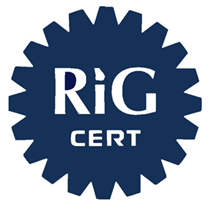ISO 9001 - Quality management

ISO 9001 is probably the most popular standard in the world.
First published in 1987 and revised several times since then (1994, 2000, 2008, and most recently in 2015), ISO 9001 helps organizations establish a quality management system.
The current version of the standard is the one published in 2015. ISO 9001 is based on internationally recognized principles of quality management, such as customer focus, leadership, process approach, engagement of people or continual improvement.
ISO 9001 is applicable to all types of organizations—regardless of size, sector, or location. It is used by manufacturers, service providers, public institutions or NGOs seeking to demonstrate consistent quality, enhance customer satisfaction and drive operational efficiency.
RIGCERT provides accredited certification services for quality management systems in accordance with ISO 9001. Our certification process is impartial, transparent, and conducted by experienced professionals who understand your industry.
Whether you are aiming to improve internal processes, meet customer requirements, or access new markets, our ISO 9001 certification can support your goals.
ISO 9001 is a management system standard focused on governance aspects rather than on specifying requirements for an organization’s specific products or services. Because it applies to any organization—regardless of size or sector—its requirements are generic and must be interpreted within the organization’s specific context, taking into account its products and services.
Top management involvement
A critical success factor for an effective quality management system (QMS) is the active involvement and support of top management. They are responsible for establishing a quality policy and quality objectives, communicating the importance of meeting customer and regulatory requirements, and providing the necessary resources for the QMS.
Key requirements of ISO 9001
Implementing a QMS according to ISO 9001 involves meeting a series of requirements. One of the first steps is to clearly define and document the scope of the quality management system, so that its boundaries and applicability are well established.
Organizations must also identify and address risks and opportunities that could influence their ability to consistently deliver products and services that meet customer and regulatory requirements. Personnel competence is another key requirement—employees should receive appropriate training and be aware of how their roles contribute to quality objectives.
The design and development of products and services must be planned and controlled to ensure that outcomes meet expectations.
Communication with customers should be effective and maintained throughout the relationship, including a process for managing customer complaints.
External providers—such as suppliers or subcontractors—must be carefully managed to ensure that outsourced processes and deliverables comply with requirements. When outputs do not meet expectations, organizations must manage nonconforming outputs in line with documented procedures, ensuring appropriate actions are taken.
Property belonging to customers or other external parties and held by the organization must be protected from loss, damage, or misuse.
To maintain and improve the QMS over time, organizations are expected to monitor and measure operational performance and gather feedback on customer satisfaction. Internal audits must be conducted at planned intervals to evaluate whether the system functions effectively and in accordance with ISO 9001. Additionally, regular management reviews are required to assess the system’s suitability, adequacy, and effectiveness, and to support decisions for continual improvement.
When problems occur, nonconformities must be addressed through appropriate corrective actions aimed at eliminating root causes and preventing recurrence.
At the heart of ISO 9001 lies the principle of continual improvement, encouraging organizations to refine their processes and strengthen their quality management system on an ongoing basis.
An ISO 9001 Quality Management System (QMS) certification is granted following a successful initial audit, conducted in two stages by competent and impartial auditors.
The certification is valid for three years, during which annual surveillance audits are carried out to confirm that the organization’s QMS continues to meet the standard’s requirements.
If surveillance audits are missed or if they reveal significant nonconformities, the certification may be suspended or even withdrawn.
At the end of the three-year certification cycle, the organization can choose to undergo a recertification procedure, which is conducted under similar conditions to the initial cycle.
At RIGCERT, we offer accredited certification services for Quality Management Systems in accordance with ISO 9001. Our approach is tailored to the specific needs and realities of your industry, ensuring a certification process that is both relevant and efficient.
Our accreditation by ESYD, the Greek National Accreditation Body, guarantees that your certificate is recognized and accepted by authorities, business partners, and other stakeholders. ESYD is a founding member of both EA (European co-operation for Accreditation) and IAF (International Accreditation Forum), which means that your certification benefits from global recognition and trust.





